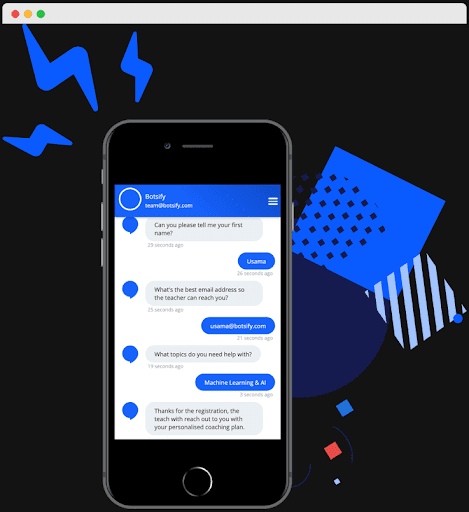Artificial intelligence (AI) has transformed all types of industries. From healthcare, and business, to transportation, hospitality, education, and security, AI has become revolutionary in all aspects. This is true for making an impact through conversational AI in e-commerce, particularly in e-commerce messaging.

The messaging revolution in e-commerce increased the use of messaging platforms and chatbots for customer service and sales in online shopping. Consumers’ growing preference for instant, convenient, and personal communication and advancements in AI and natural language processing has been driving this trend. Messaging in e-commerce allows for real-time interactions, quicker resolution of customer inquiries and issues, and an improved overall shopping experience.
What is conversational AI in e-commerce?
Conversational AI in e-commerce refers to using natural language processing (NLP) and AI technologies to enable customers to interact with e-commerce platforms through voice or text-based conversations. This technology aims to provide a more personalized and human-like customer service experience by allowing customers to ask questions, make purchases, and receive support conversationally. Conversational AI in e-commerce aims to enhance customer engagement, improve customer satisfaction, and streamline sales and approval processes.
Types of conversational AI
There are several types of conversational AI, including:
-
Rule-Based Conversational AI:
A rule-based AI is a type that uses a set of predefined rules to respond to user queries. It operates by matching user inputs to a set of predetermined rules and providing a corresponding response based on those rules. This type of conversational AI is often used in simple chatbots, where the interactions are limited and straightforward. It is typically easy to implement and maintain but may struggle to handle complex or unpredictable conversational scenarios and provide a more human-like response.
-
Retrieval-Based Conversational AI:
Retrieval-based AI is a type of conversational AI that utilizes a pre-populated database of responses to return a relevant answer to the user. It operates by finding the closest matching response in its database to the user’s input and returning that as the answer. This type of AI is often used in customer service chatbots, where many frequently asked questions can be pre-populated and quickly retrieved as needed. It can provide quick and accurate answers to specific inquiries but may need help with more complex or open-ended conversation scenarios.
-
Generative Conversational AI:
This is an artificial intelligence system designed to generate human-like responses in natural language in real time. It uses deep learning algorithms and large training data to generate coherent and contextually appropriate text. The AI model can be trained on various topics and used in various applications such as chatbots, virtual assistants, and conversational interfaces.
Generate More Leads With Website & Messenger Chatbots
Gather quality leads on autopilot and 10x your ROI with automated chats
-
Hybrid Conversational AI:
This refers to an AI system that combines rule-based and machine learning (ML) approaches to generate responses. It uses a combination of hand-crafted rules and algorithms to generate responses in real time. The hand-crafted rules provide a basic understanding of the context and help the system handle simple, straightforward queries, while the ML algorithms handle more complex nuanced interactions. The hybrid approach balances the accuracy and efficiency of rule-based systems and the flexibility and adaptability of ML-based systems.
-
Task-Oriented Conversational AI:
Task-oriented AI is a type that is designed to perform specific tasks or carry out transactions through a conversational interface. It is often used in customer service, e-commerce development, and other applications where the goal is to complete a specific task, such as booking a flight or ordering a product. Task-oriented conversational AI uses NLP and ML algorithms to understand the user’s request and respond appropriately. The system is trained on a set of specific tasks. It is designed to handle a limited conversation scope, making it more focused and efficient than general conversational AI systems.
-
Open-Domain Conversational AI:
This artificial intelligence system is trained on a wide range of topics and is capable of having general conversations with users about any topic. Unlike task-oriented AI, open-domain conversational AI does not have a specific task or transaction in mind. Instead, its goal is to have a natural and engaging conversation with the user.
Discussion
This type of AI typically uses large language models such as GPT-3 to generate responses. Users can use it in applications such as chatbots, virtual assistants, and social media bots. The open-domain nature of these systems makes them more versatile and flexible but also more challenging to train. They need to handle various topics and respond to unpredictable user inputs.
Examples of conversational AI
Chatbots: Automated programs that use natural language processing to understand and respond to customer requests through text or voice interactions.

Virtual Assistants:
Artificial intelligence systems that can perform tasks, provide information, and answer questions, such as Apple’s Siri or Amazon’s Alexa.
Customer Service Bots:
Chatbots specifically designed for customer service and support can handle various customer inquiries and issues.
Language Translation Bots:
Chatbots that can translate conversations between languages in real time.
Personal Shopping Bots:
Chatbots that can provide personalized shopping recommendations, answer product-related questions and assist in the purchase process.
Virtual Interview Bots:
Chatbots that can conduct job interviews and screen candidates by asking predetermined questions.
These are some of the most common examples of conversational AI, but the technology is constantly evolving, and new applications are being developed constantly.
How will conversational AI transform e-Commerce?

Aside from e-commerce software solutions, conversational AI has the potential to significantly transform e-commerce by providing a more convenient and personalized shopping experience to customers. Some of the ways conversational AI is likely to impact e-commerce include the following:
Improved customer service
Conversational AI, or chatbots, can improve customer service in the following ways:
24/7 Availability:
Chatbots can be available 24/7 to answer customer questions and provide support, even outside business hours.
Quick Response Times:
Chatbots can quickly respond to customer inquiries, reducing wait times and improving the overall customer experience.
Personalized Interactions:
Conversational AI can use natural language processing to understand customer requests and provide personalized responses, creating a more human-like experience.
Scalability:
Conversational AI can handle many customer interactions simultaneously, enabling companies to scale their customer service operations to meet demand.
Discussion
Overall, conversational AI can provide improved customer service by delivering quick, efficient, and personalized interactions and freeing up customer service agents to focus on higher-value tasks.
Personalized shopping experiences
Conversational AI can provide a personalized shopping experience through the following capabilities:
Personalized Recommendations:
Chatbots can use data such as previous purchases, browsing history, and customer preferences to recommend products tailored to the individual shopper.
Context-Aware Interactions:
Chatbots can understand the context of a customer’s request and provide relevant information and suggestions based on the current conversation. For instance, it can be a great help for artists who are looking for the right brush for their illustrations on a site.
Natural Language Processing:
Conversational AI can understand and respond to customer requests in a human-like manner, creating a more personal and engaging shopping experience.
Customer Profile Management:
Chatbots can store and track customer information, allowing them to remember and use past interactions to provide more relevant recommendations and information in future interactions.
Seamless Integration with Other Systems:
Chatbots can be integrated with other systems, such as order management, inventory management, and payment systems, to provide a seamless and convenient shopping experience.
Discussion
By leveraging these capabilities, conversational AI can provide a personalized shopping experience that is more engaging, relevant, and convenient to customers.
Increased sales
Conversational AI can increase sales in a business by utilizing the following strategies:
Upselling and Cross-selling:
Chatbots can use customer data and purchase history to recommend complementary or higher-priced products, increasing average order value.
Improved Customer Engagement:
Conversational AI can provide a more personal and interactive shopping experience, increasing customer engagement and building brand loyalty.
Streamlined Purchase Process:
Chatbots can automate the purchase process, making it faster and more convenient for customers and reducing friction in the sales process.
Promotions and Offers:
Chatbots can send personalized promotions and offer to customers based on their purchase history, preferences, and behavior, increasing the effectiveness of marketing campaigns.
Discussion
Through these strategies, AI can increase sales and improve customers’ overall shopping experience, driving business growth.
Reduced costs
This AI can reduce costs in a business in several ways:
Automation of Repetitive Tasks:
Chatbots can automate repetitive and time-consuming tasks, such as answering frequently asked questions, freeing human customer service agents to focus on more complex issues.
Scalability:
Chatbots can handle a large volume of customer interactions simultaneously, reducing the need for additional customer service staff as the business grows.
Increased Efficiency:
Chatbots can provide quick and accurate responses to customer inquiries, reducing resolution times and increasing overall efficiency.
Reduced Training Costs:
Chatbots do not require training like human customer service agents do, reducing the cost of training and onboarding new employees.
Discussion
By utilizing AI, businesses can reduce customer service costs while improving the overall customer experience. This can lead to significant cost savings, improved efficiency, and increased profitability.
Conversational AI is a big part of the future of e-Commerce
Artificial intelligence indeed contributes a big chunk to e-commerce automation. From customer support to sales and marketing, it revolutionizes every industry. With conversational AI, businesses have the potential to enhance the e-commerce experience significantly.
Generate More Leads With Website & Messenger Chatbots
Gather quality leads on autopilot and 10x your ROI with automated chats

